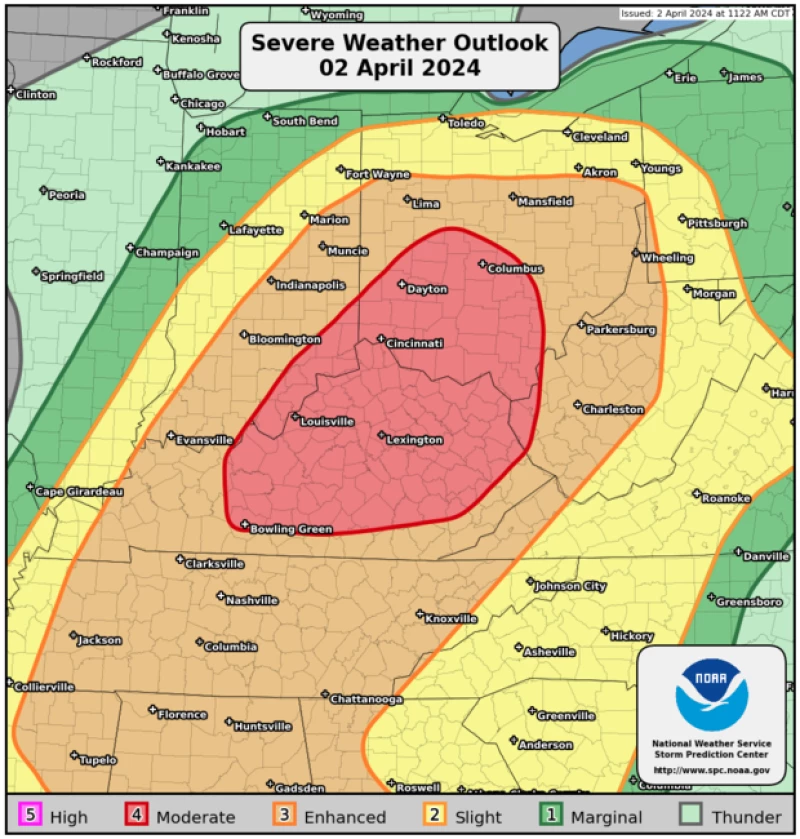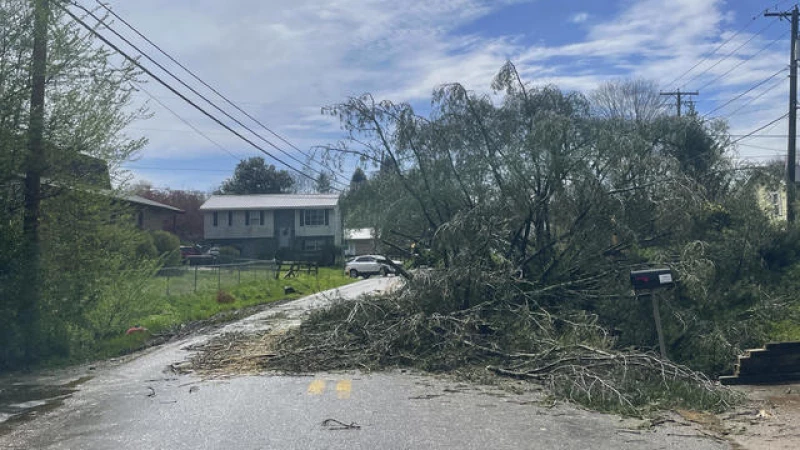Violent Storms Sweep Through Ohio and Tennessee Valleys
A surge of destructive storms lashed multiple states across the Ohio and Tennessee Valleys on Tuesday, with various tornado watches impacting millions and severe weather warnings spreading over a much wider slice of the country, from the Gulf Coast to the Great Lakes.
Violent wind gusts and heavy rain had already caused serious damage to some areas by mid-afternoon, wrecking buildings and forcing highway closures as crews worked to clear downed power lines, trees and other debris.
Large sections of Ohio and Kentucky were contending with the most serious risks, along with a stretch of far-eastern Indiana. The Storm Prediction Center's most recent severe weather outlook ranked threats in parts of those states at Level 4, of five levels, just before 12 p.m. CDT. Level 4 corresponds with "moderate" on that scale. Much of Kentucky and southern Ohio received that warning, including major cities like Cincinnati, Columbus, Dayton, Lexington and Louisville.
A tornado watch was also in effect for parts of central Kentucky and Tennessee, including Nashville and its surrounding areas. They are set to expire at 3 p.m. CDT, although meteorologists warned that powerful "and potentially long-track tornadoes are possible from Indiana and Ohio southward into the Mid South."
"There is a potential for strong tornadoes to develop this evening and tonight in parts of Alabama and Georgia," as stated by the storm prediction center.
Another tornado watch was in place until 6 p.m. for areas of western Kentucky, southern Illinois, southwestern Indiana, and southeastern Missouri.
Overall, the forecast suggested the possibility of severe thunderstorms affecting parts of these states along with northeastern Mississippi, southeastern Illinois, and southwestern Virginia on Tuesday. The primary hazards included the potential for "a few intense" tornadoes, damaging winds, which could reach hurricane force, and large hail, possibly as big as baseballs.

When winds sustain a speed of 74 miles per hour or higher, they are classified as "hurricane-force" on the Saffir-Simpson Scale. While all thunderstorms have the potential to generate tornadoes, specific atmospheric conditions must be present for tornado formation. Meteorologists issue tornado watches when a combination of severe weather events and atmospheric conditions indicate the possibility of tornado formation in an area, although it does not guarantee that a tornado will occur.
Powerful storms had already uprooted trees in Kentucky by midday on Tuesday. CBS affiliate WKYT shared a video of some of the damage, which included large branches, trunks and other debris splayed out over an intersection in a residential part of Lexington. In Nicholasville, another city nearby, authorities said they were investigating "a significant weather event" that impacted an industrial area. Images shared on social media appeared to show at least one structure partially torn apart after the incident.
Meanwhile, a series of brutal storms barreled through parts of West Virginia throughout the day on Tuesday, with video footage capturing powerful gusts of wind picking up debris in the city of Charleston. The National Weather Service said radar indicated that there was a tornado in the Charleston area on Tuesday morning. Meteorologists forecasted those storms to abate to some degree as the system tracked toward Virginia.
The tumultuous storm system ripped through other parts of the country as it has continued traveling east. Earlier, as it struck Oklahoma, a 46-year-old woman in Tulsa was swept away by flooding on Monday night. Andy Little, the public information officer for the Tulsa Fire Department, told CBS News that crews were still searching for her on Tuesday morning.
Anticipating the upcoming week, meteorologists have warned of a "slight risk" of strong and severe storms hitting regions along a significant portion of the East Coast and slightly inland on Wednesday. The potential storms could bring hail, damaging winds, and even a tornado or two to areas within the risk zone, spanning from the Chesapeake Bay down to Florida.







